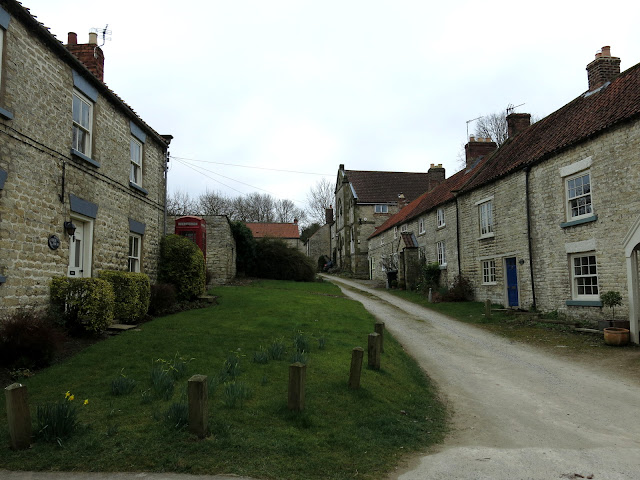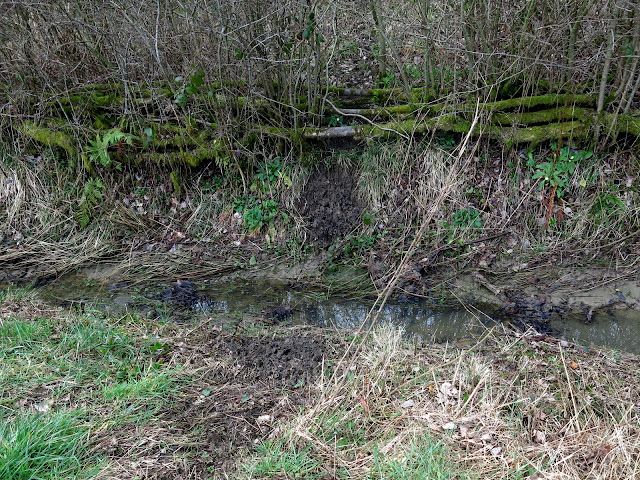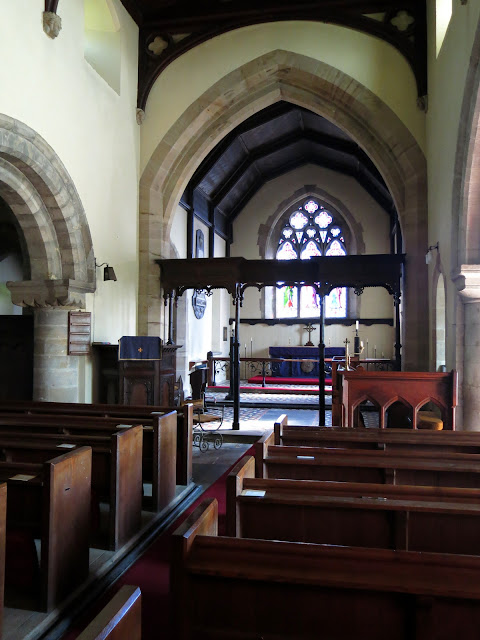Stonegrave and Caulkleys Bank from Nunnington
7 miles Fine and bright
This is the most southerly walk in The Walker's Guide to the Hambleton Hills and we approached it from the B1257 Malton road. We parked opposite Nunnington Hall in a small layby next to the River Rye.
 |
| Today's walk from The Walker's Guide to the Hambleton Hills |
 |
| Swans near our car |
 |
| Nunnington Hall from car park |
Tom Scott Burns explains that the name Nunnington is derived from the Old English personal name Nunna and surprisingly not from the Saxon nunnery that was originally on the site of Nunnington Hall. We walked through the village where our route left the road at a sign to follow the winding path of the River Rye.
 |
| Weather vanes in Nunnington |
 |
| Nunnington is laid out with streets forming a grid design |
 |
| We leave the village to follow the river |
As we left the village at its north west corner a waymarker points into a field and we followed its direction alongside the river. After about a mile we crossed a small bridge and turned left to walk into a field alongside a plantation of small trees. As we turned into the field we saw three deer grazing at the far end of the field. Needless to say they also saw us and by the time my camera was ready there was only one deer in sight, and that disappeared into the plantation a second later. As we walked up the field away from the river we saw several points where the deer have established paths into the plantation.
 |
| A long walk alongside the river bank on a faint path |
 |
| Debris on the ruined bridge showed the river had been in flood |
 |
| Vegetation |
 |
| Over the bridge and turn right away from the river |
 |
| One photo then I'm off.. |
 |
| Deer track into the plantation |
We reached the tarmac of High Moor Lane, turned left and then after a couple of hundred yards turned right again into more fields which we crossed to reach the B1257 road and the pretty village of Stonegrave.
 |
| Our paths were not well walked |
 |
| We turn left towards.... ? (actually Stonegrave) |
 |
| Limestone path |
 |
| Houses in Stonegrave |
 |
| Our passing is observed.. |
We walked through the village, foregoing our path to Caulkleys Bank as we wanted to see the Minster, the smallest in the country, which has been on this site since the 8th century.
The village name is derived from the old Norse steinn-gryfja, meaning 'stone cleft' and in the Middle Ages there were stone quarries all round this region.
We turned off the B1257 and past the Elizabethan manor house and approached the picturesque minster which is mentioned in an 8th century letter from Pope Paul I to King Eadbert of Northumbria.
 |
| Male sparrowhawk near the minster |
 |
| Stonegrave Manor House |
 |
| Stonegrave Minster |
 |
| A good spot for coffee and scones |
By now the sun was out and the wind had dropped. Our coats were off and we were ready for coffee and scones. Fortunately in front of the minster was a bench facing the sun so we enjoyed our break in lovely surroundings before exploring the minster and its graveyard.
 |
| 10th Century Celtic Cross |
The minster was unlocked and a sign said that visitors were welcome to enter.
 |
| Altar window |
 |
| Memorial stones in Stonegrave Minster |
We retraced our steps to reach the footpath to Caulkleys Bank. The name Caulkleys is a corruption of 'chalk lands'. The path runs off the B1257, sign-posted 'Caulkleys Bank' and we followed the grassy path uphill and alongside a small wood. Reaching the top our path became an exhilarating ridge walk which we followed for the next 2.5 miles. TSB claims that no less than 22 towns, villages and hamlets and sixteen churches may be seen from the ridge's highest point. We didn't check. Eventually we started to drop gently down to the houses of West Ness and back to the River Rye.
 |
| Sign leaving the B1257 |
 |
| Starting to climb Caulkleys Bank and looking down on the Manor House |
 |
| Caulkleys Bank |
 |
| Stonegrave and the Minster |
 |
| I stride out on the green road alongside Caulkleys Wood |
 | |
| Trig Point - TSB says we should be able to see 22 villages from this point |
 |
| Caulkleys Lane |
As we entered the hamlet of West Ness we saw a little stall outside West Ness Hall Farm. Exploring further we found a nice display of home made cakes and were both tempted into making purchases. We placed our money in a little cash box, a very trusting arrangement although there was a CCTV notice on display to deter the dishonest.
 |
| Descending to West Ness |
 |
| "This looks interesting" |
 |
| "It is!" |
As we passed West Ness Hall Farm we saw a farmer carrying two lambs from the farm buildings into a field and being followed by a ewe. He must have decided that he would take out the newborns for some sun and he carefully put them down only for the ewe to firmly push one of the lambs away. He had brought out another ewe's lamb by mistake! We stopped to watch as he picked up the unwanted lamb and walked back to the building to re-appear in a couple of minutes carrying another lamb. This time he had got it right and the family went off happily together.
 |
| "That's not mine!" |
 |
| The walk of shame |
 |
| How to carry a lamb |
 |
| "Try this one." |
| Mum! |
We passed by an old Wesleyan Chapel, built in 1836 but now obviously disused, and joined a riverside track just left of the bridge. We followed the river for 1.5 miles as we walked back to Nunnington. As we approached Nunnington Mill a couple of herons flew lazily into the trees but still too quickly for my camera. TSB says that there has been a mill on this site since Domesday but the present building dates from 1875. We wandered over to look at the mill race which powered electricity for Nunnington Hall from 1920 to 1950.
 |
| A beautiful riverside walk |
 |
| Nunnington Mill |
 |
| Mill and farm buildings |
 |
| The mill race |
Leaving the mill behind us the river path took us back to Nunnington and to Nunnington Hall, which was owned by Sir Thomas Parr in the 16th century. It's quite possible that Catherine Parr, Henry VIII's last wife, could have played here as a child.
We were fascinated by some sheep in a field at the hall that had the distinct look of teddy bears. They were in fact Old English Southdown Sheep. We were unable to see their eyes and wondered how well they could see but they certainly looked cute.
 |
| We walk past the rear of Nunnington Hall |
 |
| Old alms houses, now Nunnington Village Hall |
 |
| Sheep at Nunnington Hall |
 |
| Southdown Sheep |
Time was pressing on so we decided to forgo visiting the Church of All Saints and St James on this occasion and instead took ourselves to the Royal Oak at the top of the village, where we sat outside in the afternoon sun and enjoyed a pint of Theakston's Bitter.
A lovely walk and highly recommended.
 |
| "Cheers!" |
 |
| Nunnington Hall and the River Rye |












No comments:
Post a Comment